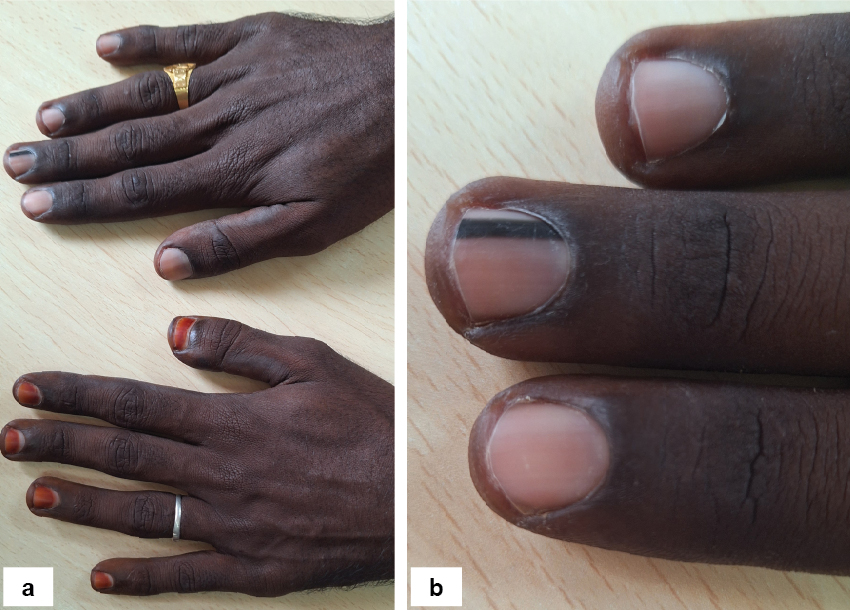Published in IJCP
October 2023
Images In Clinical Practice
An Interesting Case of Chromonychia in an Immunosuppressed Individual
October 10, 2023 | Rajesh Rajagopalan
Dermatology
https://doi.org/10.59793/ijcp.v34i5.680
A 28-year-old unmarried promiscuous bisexual man with a history of human immunodeficiency virus (HIV) infection for past 2 years on triple drug regimen (efavirenz/emtricitabine/tenofovir disoproxil fumarate) but highly irregular, now on antituberculosis treatment (ATT) for pulmonary tuberculosis for past 4 months, presented with linear pigmented band on right middle finger nail for past 8 months. There was no history of trauma. He denied pain or tenderness. Otherwise he felt well and reported no other systemic symptoms except occasional dry cough. General physical and systemic examinations were unremarkable.
On local examination, there was a linear black discoloration of right middle finger nail with no discoloration of periungual skin (Hutchinson’s sign was negative). Nails on the left hand were distally orangish red due to henna pigmentation (Fig. 1 a and b). Nail clippings for potassium hydroxide (KOH) mount were negative for fungal hyphae. A diagnostic nail biopsy was deferred as onychoscopy confirmed the diagnosis. His Venereal Disease Research Laboratory (VDRL) and other viral markers were unremarkable. Patient was assured and as his CD4 cell count was very low (18 cells/mm3), his regimen was changed to 3-drug regimen containing dolutegravir/emtricitabine/tenofovir alafenamide. He was asked to continue ATT.

Figure 1 a and b. Longitudinal black band involving solitary digit.
- What is the most likely underlying diagnosis?
- Benign longitudinal melanonychia
- Drug-induced pigmentation
- Onychomycosis due to molds
- Nail matrix nevus
- Subungual melanoma
Answers:
- Benign longitudinal melanonychia – correct. Melanonychia striata is the commonest morphological pattern.1 Longitudinal brown-black band extends proximally from nail matrix or cuticle to distal free edge of the nail plate.
- Incorrect. Drugs such as antiretroviral therapy (ART) (zidovudine)2 or cancer chemotherapeutics usually causes diffuse black pigmentation of multiple nails. Exogenous pigments can also cause melanonychia, but they usually do not form regular linear bands.
- Incorrect. More than one nail involvement with KOH mount revealing fungal hyphae. Often nails are dull, brittle with subungual hyperkeratosis/periungual inflammation. Longitudinal melanonychia is more common with dermatophytes like Trichophyton rubrum while diffuse pigmentation is seen with molds such as Scytalidium, Aspergillus niger and Alternaria.
- Incorrect. Nail matrix nevus and constitutional nail pigmentation (racial) are the most common causes of nail melanosis. Melanonychia in such cases result from nail matrix melanocyte proliferation with (nevus) or without nest formation (lentigine). Nail matrix nevi are commonly seen in childhood (congenital or acquired).
- Incorrect. Involvement of nail matrix by malignancy though rare is seen. Dermoscopy of the hyponychium and periungual tissues permits discovering the micro-Hutchinson sign, a periungual pigmentation. Despite its rarity, when melanoma of the nail unit occurs, it may portend a poorer prognosis and lower survival than melanoma of other sites.3
- All the following are correct about this condition except:
- Longitudinal melanonychia is a rare clinical condition.
- Mostly characterized by the presence of longitudinal, demarcated and pigmented bands on the nail unit.
- Etiology is generally classified as melanocytic activation or melanocytic hyperplasia.
- It is important to distinguish malignant melanoma from benign melanonychia as prognosis is different.
- History, physical examination, onychoscopy and nail biopsy are obtained or performed to help determine the diagnosis.
Answer:
- It is not rare but quite common in dark-skinned races, especially in people of African descent. The incidence in whites is very low at around 1%.
- All the following are true about this condition except:
- The thumbnails, index fingernails and great toenails are the most affected.
- Mostly benign; very few cases turn out to be nail melanoma.
- It can appear before, during or sometimes after pregnancy.4,5
- Laugier-Hunziker, Peutz-Jegher, Touraine syndromes are sometimes associated with this condition.
- Hutchinson’s sign is not pathognomonic of subungual melanoma.
Answer:
- If the melanin pigment extends into the skin and soft tissue surrounding the nail plate, such as the eponychium, hyponychium or lateral grooves; it is identified as a positive Hutchinson’s sign, which is considered to be almost pathognomonic of subungual melanoma and usually requires attention and further examination.6,7
REFERENCES
- Bae SH, Young MY, Lee JB. Distinct patterns and aetiology of chromonychia. Acta Derm Venereol. 2018;98(1):108-13.
- Brodland The treatment of nail apparatus melanoma with Mohs micrographic surgery. Dermatol Surg. 2001;27(3):269-73.
- Cribier B, Mena ML, Rey D, Partisani M, Fabien V, Lang JM, et al. Nail changes in patients infected with human immunodeficiency virus. A prospective controlled study. Arch Dermatol. 1998;134(10):1216-20.
- Monteagudo B, Suárez O, Rodríguez I, Ginarte M, León A, et al. Longitudinal melanonychia in pregnancy. Actas Dermosifiliogr. 2005;96(8):550.
- Fryer JM, Werth VP. Pregnancy-associated hyperpigmentation: longitudinal melanonychia. J Am Acad Dermatol. 1992;26(3 Pt 2):493-4.
- Rook A, Wilkinson DS, Ebling FJB, Champion RH, Burton JL (Eds.). Rook’s Textbook of Dermatology. 4th Edition. Blackwell Scientific Publications.
- Levit EK, Kagen MH, Scher RK, Grossman M, Altman E. The ABC rule for clinical detection of subungual melanoma. J Am Acad Dermatol. 2000;42(2 Pt 1):269-74.
|